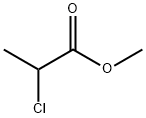| Identification | More | [Name]
Methyl 2-chloropropionate | [CAS]
17639-93-9 | [Synonyms]
2-CHLOROPROPIONIC ACID METHYL ESTER
(+/-)-METHYL 2-CHLOROPROPIONATE
METHYL 2-CHLOROPROPIONATE
METHYL A-CHLOROPROPIONATE
2-chloro-propanoicacimethylester
2-chloro-propionicacimethylester
alpha-Chloropropionic acid methyl ester
CH3CHClC(O)OCH3
Methyl alpha-chloropropionate
Propanoic acid, 2-chloro-, methyl ester
Propionic acid, 2-chloro-, methyl ester
2-CHLOROPROPANOIC ACID METHYL ESTER
METHYL(OR ETHYL) (S)-(-)-2-CHLOROPROPIONATE
Methyl 2-chloropropionate, 98+%
2-Chlorpropionsuremethylester
Methyl DL-a-chloropropionate
2-Chloropropionic acid methyl
NSC-70983 | [EINECS(EC#)]
241-624-5 | [Molecular Formula]
C4H7ClO2 | [MDL Number]
MFCD00000863 | [Molecular Weight]
122.55 | [MOL File]
17639-93-9.mol |
| Chemical Properties | Back Directory | [Appearance]
clear colorless liquid | [Melting point ]
-10 °C
| [Boiling point ]
132-133 °C(lit.)
| [density ]
1.075 g/mL at 25 °C(lit.)
| [vapor density ]
4.22 (vs air)
| [vapor pressure ]
5.25 mm Hg ( 20 °C)
| [refractive index ]
n20/D 1.417(lit.)
| [Fp ]
101 °F
| [storage temp. ]
Flammables area | [solubility ]
Chloroform, Ethyl Acetate (Slightly), Methanol (Slightly) | [form ]
clear liquid | [color ]
Colorless to Almost colorless | [Specific Gravity]
1.075 | [PH]
6-7 (H2O, 20℃) | [Stability:]
Stable. Flammable. Incompatible with strong oxidizing agents. | [explosive limit]
2.8-13.9%(V) | [Water Solubility ]
immiscible | [BRN ]
1421535 | [CAS DataBase Reference]
17639-93-9(CAS DataBase Reference) | [NIST Chemistry Reference]
Methyl 2-chloropropionate(17639-93-9) | [EPA Substance Registry System]
17639-93-9(EPA Substance) |
| Safety Data | Back Directory | [Hazard Codes ]
Xi | [Risk Statements ]
R10:Flammable.
R36/37/38:Irritating to eyes, respiratory system and skin . | [Safety Statements ]
S26:In case of contact with eyes, rinse immediately with plenty of water and seek medical advice .
S36:Wear suitable protective clothing .
S37/39:Wear suitable gloves and eye/face protection .
S16:Keep away from sources of ignition-No smoking . | [RIDADR ]
UN 2933 3/PG 3
| [WGK Germany ]
1
| [RTECS ]
UE9100000
| [Autoignition Temperature]
430 °C DIN 51794 | [TSCA ]
Yes | [HazardClass ]
3 | [PackingGroup ]
III | [HS Code ]
29159080 | [Safety Profile]
Poison by
intraperitoneal route. See also ESTERS. A
flammable liquid when exposed to heat or
flame. When heated to decomposition it
emits toxic fumes of Cl-. |
| Raw materials And Preparation Products | Back Directory | [Raw materials]
Propionic acid-->1-Butene, 2,3-dichloro--->Methyl DL-2-aminopropanoate hydrochloride-->DALAPON-METHYL ESTER-->3-CHLOROPROPIONIC ACID METHYL ESTER-->2-CHLORO-1,1-DIMETHOXYPROPANE-->Methanol, 1-chloro-,1-propanoate-->Methyl 2-bromopropionate-->Methyl lactate-->2-Chloropropionyl chloride | [Preparation Products]
Phenylacetone-->(S)-(-)-2-Chloropropionic acid-->Dimethyl methylmalonate-->3,4-Dimethoxyphenylacetone-->2-Chloro-1-propanol-->1-Oxaspiro[2.4]heptane-2-carboxylic acid, 2-methyl-, methyl ester-->2-Oxiranecarboxylic acid, 2,3,3-trimethyl-, methyl ester |
| Hazard Information | Back Directory | [General Description]
A colorless liquid. Flash point 101°F. Density 8.9 lb/gal. Insoluble in water. Irritating and narcotic in high concentrations. Used as a solvent and for making other chemicals and dyes. | [Reactivity Profile]
METHYL CHLOROPROPIONATE is a halogenated ester. Reacts with acids to liberate heat along with alcohols and acids. Strong oxidizing acids may cause a vigorous reaction that is sufficiently exothermic to ignite the reaction products. Reacts exothermically with bases. Flammable hydrogen is generated with alkali metals and hydrides. | [Air & Water Reactions]
Flammable. Insoluble in water. | [Health Hazard]
May cause toxic effects if inhaled or absorbed through skin. Inhalation or contact with material may irritate or burn skin and eyes. Fire will produce irritating, corrosive and/or toxic gases. Vapors may cause dizziness or suffocation. Runoff from fire control or dilution water may cause pollution. | [Fire Hazard]
HIGHLY FLAMMABLE: Will be easily ignited by heat, sparks or flames. Vapors may form explosive mixtures with air. Vapors may travel to source of ignition and flash back. Most vapors are heavier than air. They will spread along ground and collect in low or confined areas (sewers, basements, tanks). Vapor explosion hazard indoors, outdoors or in sewers. Runoff to sewer may create fire or explosion hazard. Containers may explode when heated. Many liquids are lighter than water. | [Chemical Properties]
clear colorless liquid | [Uses]
Methyl 2-chloropropionate is used as initiator during the synthesis of acrylamide homopolymers and acrylamide-N-isopropylacrylamide block copolymers. It is also used to produce 2-thiophen-2-yl-propionic acid methyl ester. | [Toxics Screening Level]
Emission limitations should be calculated using an AAC of 6 μg/m3 on an
annual average basis. |
|
|





